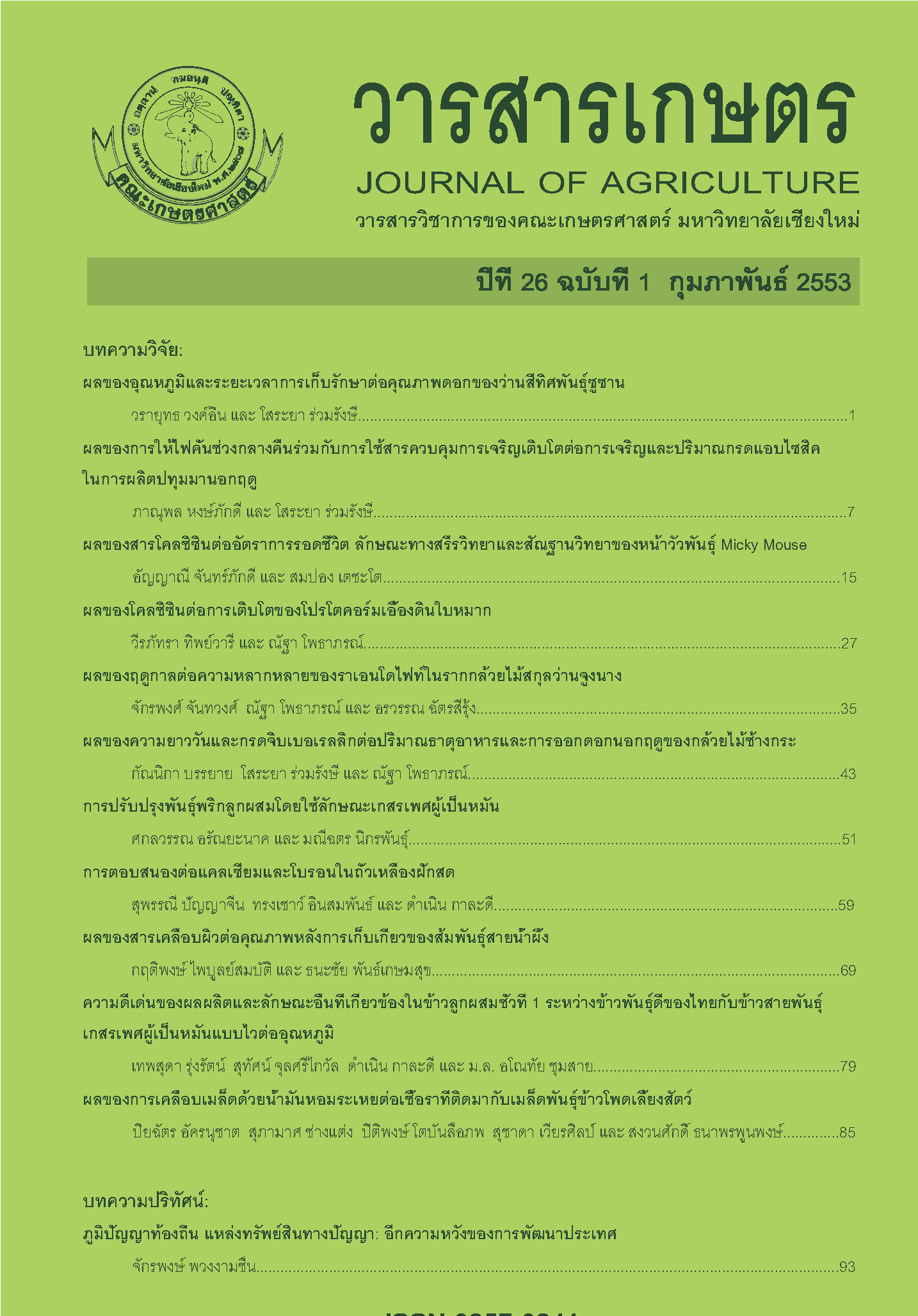Effect of Essential Oils Coating on Seed-borne Fungi in Maize Seeds
Main Article Content
Abstract
The aim of this study was to determine the efficiency of eugenol, star anise and galanga essential oils in controlling seed-borne fungi of maize seeds. First, the maize seeds were coated with a chitosan-lignosulphonate polymer followed by the essential oils of eugenol, star anise or galangal at various concentrations; 0.5, 1, 1.5 and 2 ml. Then, the coated seeds were stored for 90 days. Finally, the health of the stored, coated seeds was assayed by using the blotter method in which the fungal inhibition percentage was calculated. Of the three essential oils used in this study, eugenol proved to be the most effective antifungal agent against the pathogenic fungi. This study concluded that eugenal essential oil was effective in controlling and eliminating Aspergillus niger and Fusarium sp. in maize seeds when compared to the chemical captan.
Article Details
References
ธารทิพย์ ภาสบุตร. 2540. ผลของสารสกัดจากพืชบางชนิดที่มีต่อเชื้อราสาเหตุโรคแอนแทรคโนสของมะม่วง (Colletotrichum gloeosporioides (Penz.) Sacc.). วิทยานิพนธ์วิทยาศาสตรมหาบัณฑิต. มหาวิทยาลัยเกษตรศาสตร์, กรุงเทพฯ. 85 หน้า.
มยุรี ปละอุด. 2549. ผลของน้ำมันหอมระเหยต่อเชื้อราที่ติดมากับเมล็ดและคุณภาพของเมล็ดพันธุ์ข้าวขาวดอกมะลิ 105. วิทยานิพนธ์วิทยาศาสตรมหาบัณฑิต. มหาวิทยาลัยเชียงใหม่, เชียงใหม่. 163 หน้า.
สมบัติ ศรีชูวงศ์. 2526. เชื้อราที่ติดมากับเมล็ดพันธุ์ถั่วแดง และการป้องกันกำจัดด้วยสารเคมี. ภาควิชาโรคพืช คณะเกษตรศาสตร์ มหาวิทยาลัย เชียงใหม่, เชียงใหม่. 38 หน้า.
สืบศักดิ์ สนธิรัตน. 2540. การจัดการโรคพืช. ภาควิชาโรคพืช คณะเกษตร มหาวิทยาลัยเกษตรศาสตร์, กรุงเทพฯ. 141 หน้า.
Hammer, K.A., C.F. Carson and T.V. Riley. 1999. Antimicrobial activity of essential oils and other plant extracts. Journal of Applied Microbiology 86: 985–990.
Han, J.H. And J. Floros. 1999. Modeling antimicrobial activity loss of potassium sorbate against Bake’s yeast after heat process to develop antimicrobial food packaging materials. Food Science Biotechnology 8: 11-14.
International Seed Testing Association (ISTA). 2006. International Rules for Seed Testing. Seed Science and Technology. The International Seed Testing Association, Bassersdof, Switzerland. 540 pp.
Marín, S., A. Velluti, A.J. Ramos and V. Sanchis. 2004. Effect of essential oils on zearalenone and deoxynivalenol production by Fusarium graminearum in non-sterilized maize grain. Food Microbiology 21(3): 313-318.
Mishra, A.K. and N.K. Dubey. 1994. Evaluation of some essential oils for their toxicity against fungi causing deterioration of stored food commodities. Applied and Environmental Microbiology 60(4): 1101-1105.
Nguefack, J., V. Leth, P.H. Amvam Zollo and S.B. Mathur. 2004. Evaluation of five essential oils from aromatic plants of Cameroon for controlling food spoilage and mycotoxin producing fungi. International Journal of Food Microbiology 94: 329-334.
Patkar, K.L., C.M. Usha, H.S. Shetty, N. Paster and J. Lacey. 1993. Effect of spice essential oils on growth and aflatoxin B1 production by Aspergillus flavus. Letters in Applied Microbiology 17: 49–51.
Sanchis, V., M. Abadias, L. Oncins, N. Sala, I. Viñas and R. Canela. 1995. Fumonisins B1 and B2 and toxigenic Fusarium strains in feeds from the Spanish market. International Journal of Food Microbiology 27: 37–44.
Sinha, K.K., A.K. Sinha and G. Prasad. 1993. The effect of clove and cinnamon oils on growth of an aflatoxin production by Aspergillus flavus. Letters in Applied Microbiology 16: 114–117.
Souza, E.L., E.O. Lima, K.R.L. Freire and C.P. Sousa. 2005. Inhibitory action of some essential oils and phytochemicals on the growth of various moulds isolated from foods. Brazilian Archives of Biology and Technology 48(2): 245-250.
Sutton, J.C., 1982. Epidemiology of wheat head blight and maize ear rot caused by Fusarium graminearum. Canadian Journal of Plant Pathology 4: 195–209.
Thobunluepop, P., C. Jatisatienr, A. Jatisatienr, E. Pawelzik and S. Vearasilp. 2007. Comparison of the inhibitory effect of captan, chitosan-lignosulphonate polymer and eugenol coated seeds against rice seed borne fungi. pp. 500. In: E. Tielkes (ed.). Utilisation of Diversity in Land Use Systems: Sustainable and Organic Approaches to Meet Human Needs: International Research on Food Security, Natural Resource Management and Rural Development. Book of abstracts. Tropentag 2007. Cuvillier Verlag Göttingen.
Thobunluepop, P. 2008. Characterization of a botanical fungicide from Thai origin and its efficiency in rice production. Ph. D. Thesis. University of Göttingen, Germany. 156 pp.
Thobunluepop, P. 2009. The inhibitory effect of the various seed coating substances against rice seed borne fungi and their shelf-life during storage. Pakistan Journal of Biological Sciences 12(16): 1102-1110.
Velluti, A., V. Sanchis, A.J. Ramos and S. Marin. 2003. Inhibitory effect of cinnamon, clove, lemon grass, oregano and palmarose essential oils on growth and fumonisin B1 production by Fusarium proliferatum in maize grain. International Journal of Food Microbiology 89: 145-154.
Velluti, A., S. Marín, P. Gonzalez, A.J. Ramos and V. Sanchis. 2004. Initial screening for inhibitory activity of essential oils on growth of Fusarium verticillioides, F. proliferatum and F. graminearum on maize-based agar media. Food Microbiology 21: 649-656.


